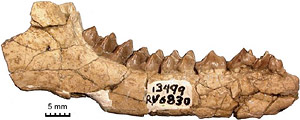



Eutheria: Fossil Record
 Right jaw of Leptoreodon leptolophus, an early artiodactyl from the Eocene of San Diego County, California. Photo by Pat Holroyd, © 2004 University of California Museum of Paleontology. |
Fossils of therian mammals, which include the marsupials as well as the eutherians, may be recognized and distinguished by the number, morphology, and replacement pattern of their teeth. However, some early Mesozoic fossils with therian characteristics have been found in Mongolia, and these cannot be definitively placed with one group or the other; that is, we are not certain which group of therian mammals they belong to, or whether they belong to some other closely related group which has since become extinct. By the Upper Cretaceous, many clearly recognizable fossils belonging to both the marsupials and eutherians can be found.
Eutherians first became common in central Asia during the Upper Cretaceous. Since the end of the Mesozoic, eutherian mammals have been the largest and most common land vertebrates, except in Australia where marsupials have been dominant. Primates, insectivores, and condylarths are recognized by the beginning of the Cenozoic, and by the start of the Eocene, most modern groups had become established.
Follow UCMP's summer 2005 excavation, in text and photos, of a partial mammoth skeleton discovered in San Jose.
Read about the recent discovery of an early mammal fossil in Australia at the Dinosaur Dreaming site in Australia.
View the Paleocene Mammals page for information about the archaic mammal species that lived between 65 and 55 million years ago.
Source:
- Carroll, R.L. 1988. Vertebrate Paleontology and Evolution. W.H. Freeman & Company, New York. 698 pp.
